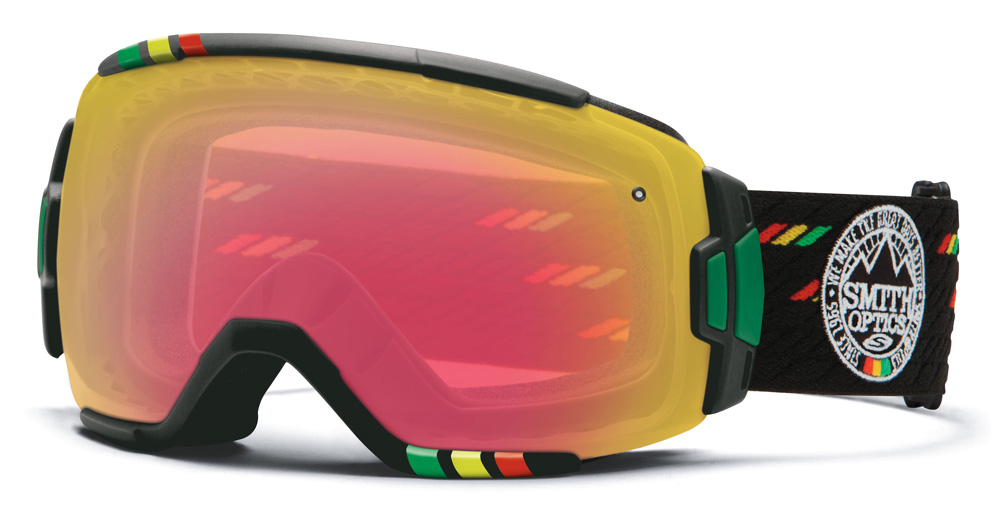Bright sun, biting wind, flying chunks of snow, and tree branches are just a few of the reasons skiers and riders wear goggles instead of sunglasses. Myriad elements including lens color and construction, venting, size, fit and materials all affect the performance and price of goggles. This guide will help you learn how to choose the best snow goggles for your needs.
FLAT LENS: Flat lenses curve in a single arc across your face but are flat from bottom to top. Flat lenses are less expensive than spherical lenses and usually have a narrower field of vision. Flat lenses are more likely to cause distortion or strange lens flares than spherical lenses. Well-designed flat lens goggles have been used for decades and are a good choice for the budget-conscious skier.
SPHERICAL LENSES: Spherical lenses are manufactured with a curved shape from side to side and top to bottom. They provide the best peripheral vision since light can enter at the same angle from the top, middle and bottom of the lens. In terms of style, spherical lenses often carry more reflective coatings and offer edge-to-edge lens with less visual frame.
LENS COLOR: Different lens colors work well in different light conditions. One way to tell how well a specific lens will work with the surrounding light is by looking at its Visible Light Transmission rating (VLT). The higher the VLT, the more light will be allowed through the lens. While color does affect the rating, the color saturation and darkness varies lens-to-lens, so check the specific model to see how much light the lenses will block.

CLOUDY DAYS: Colors like yellow and rose will enhance contrast on the hard-to-see snow surface, bringing up subtle variations in light and shadow so you can see the bumps and dips in the snow surface. These are both good colors when the snow is flying. For these types of days a VLT of 25-70 is effective
MULTI-USE: Amber and gold lenses are among the most popular colors because the work well in both sunny and cloudy conditions. These lenses provide moderate protection from midday sun. They also enhance details in shade by blocking blue light. They lose some their appeal on bluebird days when they may not be dark enough. These usually have a VLT between 20 and 70.
SUNSHINE: Grey and black lenses rule in bright sunshine, when the main purpose of the lens is to protect the eyes from glare and reflection off the snow. On the downside, dark grey and black lenses reduce visibility on overcast days when visibility is already limited. They tend to make flat light even flatter and dimmer. Look for a VLT between 10 and 20.
LOW LIGHT: For night skiing, choose pink or clear lenses for optimum visibility. These lenses also work well on extremely cloudy, snowy days. Yellow and even clear lenses are good when the sky is dumping pow. Here, a higher VLT, above 70, will be helpful.

POLARIZED LENSES: These will cut down on glare and reflections, reduce haze and make the sky really pop against clouds. For more information, read up on polarized sunglasses.
FIT: Almost all goggles can be worn with or without a helmet because of a wide range of strap adjustment. To test the fit of goggles, simply press the frame against your face. The foam should lie smoothly just above your eyebrows, around your eye sockets, against the cheek bones and over the bridge of the nose. The goggle should sit smoothly against the skin without wrinkles, pressure points or gaps.
When worn with a helmet, be sure the goggles and helmet form a close bond. You shouldn’t have any gap along your forehead – not only will this allow bare skin to get cold it also looks really uncool.
DOUBLE AND SINGLE LENSES: Much like double windows, double lenses trap a layer of air between the lenses to act like an insulator which prevents fogging by keeping the lens on the inside close to the temperature of the air on the inside and the lens on the outside close to the temperature outside. As an added bonus, the insulating air layer also helps keep your face warm.
ANTI-FOG COATINGS: Almost all goggles have some sort of anti-fog coating.
UV PROTECTION: Almost all modern goggles are rated for 100 percent UV protection, meaning the lenses block UVA, UVB and UVC rays.
VENTS: All ski goggles come with some sort of venting system. Vents are found on the top, bottom and sides of goggle frames. Enhanced venting can raise the price.

EYEWEAR COMPATIBLE: Check with manufacturers specifications to find out if a specific goggle is compatible with prescription eyeglasses. Higher volume goggles often fit over small eyeglasses.
OTHER FEATURES: Some high-end goggles have advanced features
INTERCHANGEABLE LENS SYSTEMS: Allows a single frame to hold different lenses for various light conditions. Interchange systems use magnets or mechanical attachments to hold lenses in place.
VIDEO CAMERAS: A few companies make goggles with mounted video cameras for point-of-view filming.
HEADS-UP DISPLAY: Some super high-end optics also contain cutting edge technology that displays data like speed, distances, GPS coordinates, airtime, jump distance and drop with an internal accelerometer and gyro. Cool no doubt, but get ready to break the bank.
